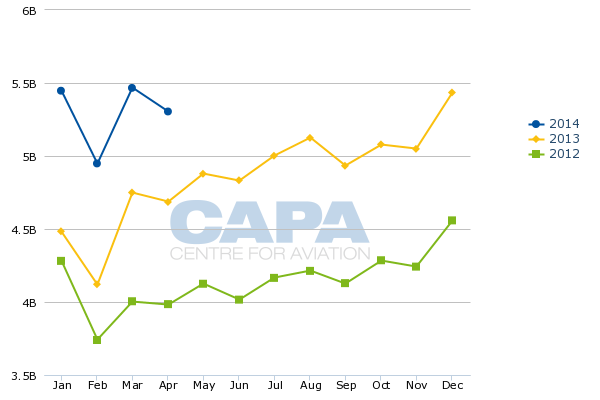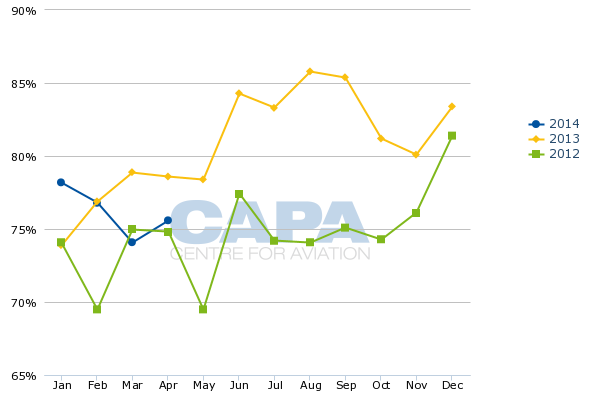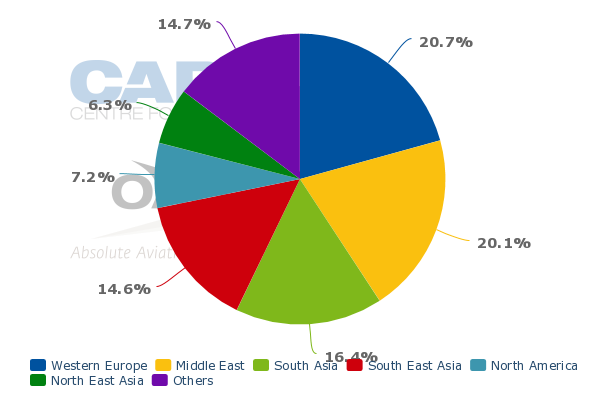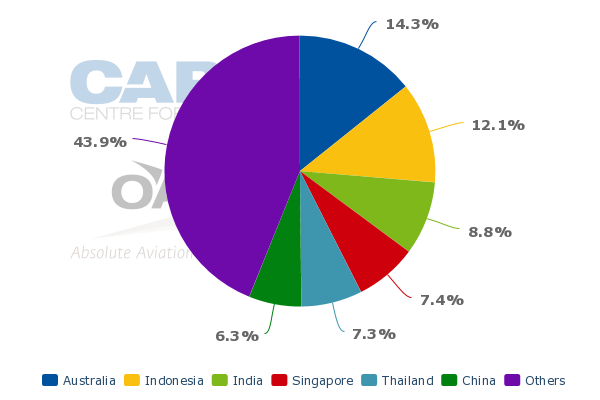Malaysia Airlines considers tie-up with Etihad Airways as restructuring process slowly begins
As Malaysia Airlines (MAS) and the Malaysian government start to consider restructuring options, the possibility of a tie-up with Etihad Airways has emerged. An MAS-Etihad partnership would be logical for both carriers and have repercussions in the dynamic Southeast Asian marketplace.
MAS would initially forge a comprehensive codeshare partnership with Etihad, building on the limited codesharing the carriers already have in place. But with Etihad an equity stake is also always a possibility. Ultimately the ball will be in the Malaysian government's court to determine if such a scenario is palpable, adding to the difficult decisions the government is already confronted with as MAS requires a deep restructuring and potentially out of the box solutions to survive.
In the meantime MAS is sounding out its oneworld partners. While MAS does not need oneworld approval to forge a relationship with Etihad, it is only courteous - and sound business practice - to give Qatar Airways and other alliance members an opportunity to come to the table with alternatives.
MAS works on restructuring plan but the process will be very slow
MAS has been working over the last one to two months on a restructuring plan aimed at adjusting its strategy to the challenging market conditions and the impact of MH370, which has significantly impacted demand from China. MAS has been consolidating some flights and is preparing some short-term capacity adjustments to mitigate losses. But a broader restructuring plan is expected to take three to 12 months before it is ready and approved for implementation.
As CAPA suggested after MAS reported a MYR443 million (USD134 million) loss for 1Q2014 on 15-May-2014, the Malaysian government needs to decide how deep a restructuring it can stomach - and then do more. Recent restructurings at MAS have not gone deep enough due to union resistance and potential political implications. The result has been a succession of tepid changes. As the situation MAS now faces is dire and vastly different from previously as it is now aggravated by MH370, it is more likely the government will this time approve a deeper restructuring.
See related report: Malaysia Airlines 1Q loss widens. Capacity growth to be adjusted, followed by restructuring
But it will take several months for the government to go through the process and make a final determination. The MAS management is capable of preparing a new business plan that has a realistic chance at bringing the carrier back to profitability within one to two years and survive over the long-term in the extremely competitive Southeast Asian marketplace. But the government, which still owns a majority stake in MAS, ultimately calls all the shots.
Bankruptcy has been ruled out at least for now, giving unions, creditors and suppliers a chance to catch their breath. Bankruptcy although initially mooted was never likely to be an acceptable outcome for the government. Malaysia also lacks the bankruptcy laws or the equivalent of Chapter 11 protection, which US carriers have been able to use over and over again to cancel contracts and successfully restructure.
A smaller MAS plus stronger partnerships could be the key to a successful future
MAS could shrink in size, erasing a period of capacity growth which the carrier pursued in part to boost efficiency levels of both aircraft and manpower. ASKs were up 17% in 2013 and 19% in 1Q2014 while RPKs increased by 27% and 18% respectively.
Malaysia Airlines monthly ASKs: Jan-2012 to Apr-2014
The surge in RPKs and load factor during 2013 came at the expense of yields as MAS engaged in deep discounting, a practice it has continued so far in 2014. But load factors, which where were up for 12 consecutive months through Jan-2014, have started trending down in recent months, providing a dismal outlook as yields remain low amid intense competition and new challenges stemming from MH370.
Malaysia Airlines monthly system-wide load factor: Jan-2012 to Apr-2014
To be sustainable MAS will likely need to be smaller while relying more on partnerships and oneworld, which it joined in early 2013, to provide a global footprint. But without an internal restructuring, MAS will remain too bloated to thrive as a smaller company. Spinning off and selling some units such as ground handling and MRO sounds like an easy downsizing solution but these units also need deep restructurings before sales can be realistically considered.
Etihad presents intriguing solution to MAS
As the Malaysian government slowly starts to come to grips with the dilemma facing MAS, Etihad has raised its hand with a potential partial solution. As is often the case, Etihad CEO James Hogan made the first move, requesting and holding a meeting with MAS CEO Ahmad Jauhari Yahya prior to the start of the IATA annual general meeting in Doha on 1-Jun-2014. (Mr Yahya left Doha prior to the start of the AGM for important meetings in Kuala Lumpur but was in Doha for a pre-AGM oneworld meeting and to meet with carriers including Etihad.)
The meeting between Mr Hogan and Mr Yahya discussed the possibility of expanding the bilateral partnership between the two carriers. It is too early at this stage to discuss equity but Etihad has developed a track record of partnering with and investing in ailing carriers, including government-owned flag airlines that no one else wants to touch.
If its investment in Alitalia is completed (Alitalia's board approved the deal on 13-Jun-2014) the Etihad "equity alliance" will grow to eight carriers. Etihad already has stakes in Aer Lingus, airberlin, Air Serbia (previously known as JAT Airways), Air Seychelles, Darwin Airline (now known as Etihad Regional), Jet Airways and Virgin Australia.
MAS could potentially add Southeast Asia to Etihad's fast-growing portfolio of airline investments. Southeast Asia is an important market for Etihad, accounting for about 15% of its current seat capacity.
Etihad currently serves six destinations in Southeast Asia with its own metal - Bangkok, Ho Chi Minh, Kuala Lumpur, Jakarta, Manila and Singapore. Kuala Lumpur is served with two daily frequencies, predominately using A330-200s.
Etihad Airways capacity share (% of seats) by region: 16-Jun-2014 to 22-Jun-2014
MAS could offer Etihad bigger synergies than Garuda
Etihad has a codeshare with Garuda Indonesia but the relationship has not evolved since it was initially forged in late 2012. MAS would potentially give Etihad a much stronger offline network in Southeast Asia as Garuda currently only gives Etihad domestic points in Indonesia. Etihad places its code on Garuda-operated flights to five offline Indonesian destinations from Jakarta and Singapore.
While domestic access to Indonesia is important, MAS can also provide Etihad with decent connectivity to Indonesia. Indonesia is MAS' second largest international market based on seat capacity. Kuala Lumpur-Bali is already one of seven MAS-operated routes covered under the limited codeshare Etihad has with MAS. The others include five domestic points in Malaysia and Singapore.
An expanded partnership would also likely include more regional destinations in Southeast Asia such as Phnom Penh and Siem Reap in Cambodia, Yangon in Myanmar, Phuket and Krabi in Thailand and Hanoi in Vietnam. Etihad already has offline access to several Southeast Asian secondary destinations through its codeshare with Bangkok Airways but a second option via Kuala Lumpur would add scale, particularly under a strong tie-up with MAS.
MAS has been focusing on expanding its regional international operation and this focus will likely continue under its new business plan as potential capacity adjustments will mainly impact medium and long-haul routes. Maintaining a strong regional network is critical as it provides feed for its partners while MAS inevitably relies more on partners outside its home region.
Australia would also likely be covered if MAS and Etihad agreed to a broader partnership. MAS serves six destinations in Australia, which is MAS' biggest single market.
Etihad currently serves only three Australia destinations, two of which (Melbourne and Sydney) are operated non-stop from Abu Dhabi. Brisbane is only served via Singapore and could potentially be moved to Kuala Lumpur under a tie-up with MAS. A fourth Australian destination, Perth, which Etihad has been serving using Garuda via Jakarta, is being added on 15-Jul-2014.
Malaysia Airlines capacity share (% of seats) by country: 16-Jun-2014 to 22-Jun-2014
Potential Garuda-SIA tie-up could put pressure on MAS to make a strategic move
Garuda recently dropped Abu Dhabi and while it still uses Etihad to provide offline access to several destinations in the Middle East and Europe it is now relying more on SkyTeam partner KLM to serve Europe via Amsterdam. (Garuda began serving Amsterdam non-stop in early Jun-2014, dropping its prior Jakarta-Abu Dhabi-Amsterdam route.)
More significantly, Garuda has been discussing a potential partnership with Singapore Airlines. While there are currently no discussions between the two companies over the approximately 40% stake Garuda is seeking to sell at budget subsidiary Citilink, there is still a possibility of a partnership on the full-service end. As CAPA analysed on 14-May-2014, a partnership between SIA and Garuda would be logical as Garuda reduces its long-haul ambitions, including plans for other non-stop services to Europe.
See related report: Garuda & Citilink 1Q losses widen. Potential Singapore Airlines investment poses intriguing option
For MAS, a strong tie-up with Etihad would improve its position in the evolving Southeast Asian market as it becomes even more competitive. Etihad could particularly boost MAS' network in Europe, the Middle East, Africa and the Americas.
MAS needs a Middle Eastern partner
MAS only operates to five European destinations while Etihad serves 17, according to OAG data. MAS no longer serves any destination in the Americas or Africa (it served two in each region until early 2012) and currently only serves two destinations in the Middle East, Dubai and Jeddah.
Dubai was resumed in Jun-2013 after initially being dropped in Jan-2012 as part of restructuring of the long-haul network (which also included Buenos Aires, Cape Town, Johannesburg and Rome; Los Angles was dropped more recently). MAS has been looking in recent months at forging more partnerships beyond Dubai to improve its performance on Kuala Lumpur-Dubai. For example MAS has been looking at adding a Dubai-Amman codeshare with Royal Jordanian. (MAS already codeshares with Royal Jordanian on the Kuala Lumpur-Bangkok-Amman route.)
MAS recognises it cannot rely entirely on local traffic for Dubai or any other Middle Eastern destination to be viable. But opportunities at Dubai are relatively limited as Dubai is dominated by Emirates with oneworld accounting for only a 5% share of capacity at Dubai.
Abu Dhabi could potentially be a more attractive option for MAS under a partnership scenario with Etihad. The Etihad Abu Dhabi hub includes 15 destinations within the Middle East and the Kuala Lumpur-Abu Dhabi route could potentially support a third daily flight (up from two daily currently operated by Etihad) with the right regional and long-haul connections. Three or even four or five daily flights on Kuala Lumpur-Abu Dhabi should be sustainable under a strong tie-up given that Emirates has five daily flights on Dubai-Kuala Lumpur while Qatar Airways has three on Doha-Kuala Lumpur.
Beyond Abu Dhabi the current Etihad-MAS codeshare is limited to three Middle Eastern points, Bahrain, Kuwait and Muscat. MAS also codeshares with Gulf Air to Bahrain and has a limited partnership with Oman Air covering Muscat as well as Beirut, Dubai and Kuwait.
Qatar Airways could present another option for MAS
A comprehensive MAS-Etihad partnership seems like a win-win. But Etihad may not be the only carrier able to improve MAS' global position as it starts preparing for another restructuring.
Qatar Airways would potentially provide some of the same network synergies. Qatar has an even bigger network in Europe, the Middle East and Africa respectively with 33, 26 and 17 destinations. While Etihad has a much smaller network than Qatar, MAS would likely be able to access the network of Etihad's other close partners, which is particularly strong in Europe as four of the airlines (soon five with Alitalia) in the Etihad Equity Alliance are European.
Qatar Airways network summary: as of 17-Jun-2014
| Total non-stop passenger destinations | 131 |
| Domestic | 1 |
| Africa | 17 |
| Asia Pacific | 45 |
| Schengen Europe | 17 |
| Other Europe | 16 |
| Latin America | 2 |
| Middle East | 26 |
| North America | 7 |
Etihad Airways network summary: as of 17-Jun-2014
| Total non-stop passenger destinations | 81 |
| Domestic | 1 |
| Africa | 7 |
| Asia Pacific | 35 |
| Schengen Europe | 7 |
| Other Europe | 10 |
| Latin America | 1 |
| Middle East | 15 |
| North America | 5 |
Qatar also could benefit from improved offline access to Southeast Asia and Australia, where it serves only two destinations - Perth and Melbourne.
MAS is informing oneworld carriers of the possibility of a partnership with Etihad. This is being done as a courtesy as oneworld allows its members to pursue partnerships outside the alliance (for example Qantas-Emirates - see background information). But being up front with what is on the table with Etihad could lead to a similar offer from Qatar or other oneworld members.
MAS was already discussing new and expanded codeshares with several oneworld members including Qatar. Currently MAS and Qatar only codeshare on Kuala Lumpur-Doha. Qatar could be compelled to advance these talks given the prospect of an Etihad-MAS partnership.
But Qatar is less likely to come to the table with an equity stake. So far Qatar's only investment in another airline, Cargolux, ended in early 2013 after less than two years and a lot of acrimony.
While Qatar is not ruling out new airline investments it is not actively seeking them. In a typical comment taking a slap at Etihad's strategy, Qatar CEO Akbar Al Baker told the CEO panel at the IATA AGM: "We will only invest in successful airlines. Not in failures."
The Malaysian government needs to make a decision - the quicker the better
Ultimately the Malaysian government may not be interested in selling a stake in MAS. If purely a partnership with a Gulf carrier becomes part of the MAS recovery strategy, Qatar could be just as well placed as Etihad and perhaps even better placed given the oneworld ties.
But if the government feels it may be best to hand the reins to a new strategic investor - and Etihad or any other airline is unlikely to invest without some control - Etihad is obviously well placed given its recent track record. Etihad could also potentially offer a solution to the expected search for a new investor in MAS Engineering given the synergies with Abu Dhabi Aircraft Technologies, which Etihad recently acquired from Mubadala.
What will unfold in Malaysia over the next several months is hard to predict. Etihad may ultimately not be interested in investing in MAS, particularly if the government is reluctant to relinquish control or allow the deep restructuring the carrier will need to be viable over the long term.
But as the sands continue to shift in Southeast Asia and globally, previously unfathomable options will get serious consideration. A comprehensive Etihad-MAS tie-up and potential equity stake could become the latest in a still growing series of moves to shake the industry.
Background information: MAS, Qantas-Emirates and oneworld
A close MAS-Etihad partnership would hardly be the first tie-up outside alliance lines. One recent relevant example of a tie-up involving another oneworld member is Qantas-Emirates.
The Qantas-Emirates partnership significantly soured MAS-Qantas relations as it was forged just as MAS was working on joining oneworld with Qantas as its sponsor. Qantas and MAS do not currently codeshare and are now unlikely to partner as Emirates is an aggressive competitor in the Malaysian market. Emirates offers non-stop services between Kuala Lumpur and Australia (which Qantas now codeshares on) as well as connections beyond Dubai throughout Europe, the Middle East, Africa and the Americas.
Qantas and MAS had been discussing a potential joint venture full-service carrier that would have operated A330s in the Australia-Malaysia market and operated within Asia. But the project, known as Orca, was dropped in early 2012 along with several other concepts raised by MAS during its prior strategy review, including a regional full-service narrowbody subsidiary (notionally known as Sapphire).
None of these projects are likely to be re-examined as the focus at MAS turns again to restructuring. But the question of a budget airline subsidiary, which MAS is alone in lacking among the main Southeast Asian flag carriers, will inevitably need to be restudied at some point.
See related report: New oneworld member Malaysia Airlines seeks to finally turn the corner in 2013 but challenges remain



